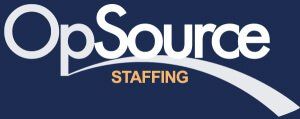Job-seekers and Employers, if you would like to discuss how OpSource Staffing Inc. can help you call us at (866) 870-8133 or Contact Us.
You’ve got a reputation for being the best coder/editor/mechanic/whatever, but it amounts to little if you don’t work well with others. Some of the most important professional skills for workers and employers alike simply can’t be taught in a classroom or measured on paper. These traits are called soft skills and they’re more crucial to your job search
and overall career
than you think.
What are soft skills?
Unlike hard skills, which can be proven and measured, soft skills are intangible and difficult to quantify. Some examples of soft skills include analytical thinking, verbal and written communication, and leadership.
Research from the Society for Human Resource
Management found that technical abilities like reading comprehension and mathematics aren’t prized as much as soft skills, meaning you have to bring more to the table than, say, great sales numbers, coding languages, or test scores.
One reason soft skills are so revered is that they help facilitate human connections. “Soft skills are key to building relationships, gaining visibility, and creating more opportunities for advancement,” says Kathy Robinson, founder of Boston career-coaching firm TurningPoint.
Basically, you can be the best at what you do, but if your soft skills aren’t cutting it, you’re limiting your chances of career
success. Read on to learn which soft skills are critical to have firmly under your belt and what steps you can take to acquire them.
Soft skills for your career
1. Communication
Why you need it:
Both written and verbal communication skills are of utmost importance in the workplace because they set the tone for how people perceive you. They also improve your chances of building relationships with co-workers. Communication skills boost your performance because they help you to extract clear expectations from your manager so that you can deliver excellent work.
Why employers look for it:
Workers are more productive when they know how to communicate with their peers, says Robinson. If you can clearly express the who, what, when, where, why, and how of a project, you’ll be a hot ticket.
How to gain it:
One way to hone your communication and presentation skills is to join Toastmasters, a national organization that offers public speaking workshops.
2. Teamwork
Why you need it:
A company’s success is rarely dependent on one person doing something all by him/herself. Success is the result of many people working toward a common goal. When employees can synthesize their varied talents, everyone wins. (Bonus: Having friends at work can also boost your job satisfaction, a Gallup poll found.)
Why employers look for it:
Employers look to team players to help build a friendly office culture, which helps retain employees and, in turn attracts top talent. Furthermore, being able to collaborate well with your co-workers strengthens the quality of your work.
How to gain it:
To generate goodwill, lend a hand when you see a co-worker in need. (“Hey, I know you have a ton on your plate. How can I help?”) Another way to build rapport is to cover for a colleague while she’s on vacation, says business etiquette and career
coach Karen Litzinger.
3. Adaptability
Why you need it:
Soft skills help you manage reality. And the reality is, things don’t always go as planned. Instead of digging in your heels, you need to be able to pivot and find alternate solutions. “Successful leaders are the ones who know how to be flexible when problems arise,” says Robinson.
Why employers look for it:
“The speed of change in any given workplace is so rapid,” says Joel Garfinkle, executive coach and author of Getting Ahead: Three Steps to Take Your Career
to the Next Level. Consequently, employers need workers who can adapt to industry shifts and keep the company current.
How to gain it:
Push yourself to be an early adopter of change. “For example, adapting to technology without mourning what used to be true yesterday is crucial for people to be seen as someone who is capable of meeting new challenges,” says Garfinkle. Inquire about training sessions and offer to teach your co-workers what you learn.
4. Problem solving
Why you need it:
When something goes wrong, you can either complain or take action. Tip: It’s the latter that will get you noticed. Knowing how to think on your feet can make you indispensable to an employer.
Why employers look for it:
Nothing is a given. Companies rely on problem solvers—a.k.a. their top performers—to navigate unexpected challenges.
How to gain it:
“Always approach your boss with a solution, not a problem,” says Robinson. So when an issue crops up, sit down and think through how you’re going to address it before bringing it to your boss’ attention.
5. Critical observation
Why you need it:
Data doesn’t mean much if you don’t know how to interpret it. Is there a pattern emerging? What else should you be looking for? Being a critical observer can help make you a better worker all around.
Why employers look for it:
Companies need critical thinkers—people who bring a fresh perspective and offer intuitive solutions and ideas to help the company get a leg up on the competition or improve internal processes.
How to gain it:
To be a critical observer, you need to be able to analyze information and put it to use. One tactic is to try to identify patterns of behavior at work. For example, does your boss actually read the weekly sales reports? What was her reaction to bad news in the staff meeting? What’s the best time of day to approach your manager with a question? By observing how people respond to the constant flow of information you can better understand the critical aspects of improving business operations.
6. Conflict resolution
Why you need it:
“Any time you put more than one person into an organization, there is going to be conflict,” says Robinson. “It’s human nature.” Therefore, being able to resolve issues with co-workers will help you maintain relationships with peers and work more effectively.
Why employers want it:
Being able to constructively work through disagreements with people is a sure indicator of maturity—as well as leadership potential. Someone like this helps to promote a healthy, collaborative workplace.
How to gain it:
The best way to resolve disagreements between co-workers is to address issues directly but delicately. So, when stepping in as a mediator, let both parties air their grievances in a judgment-free environment and then work together to find a solution.
7. Leadership
Why you need it:
Having confidence and a clear vision can help influence your co-workers and get them on board with your ideas now and in the future. Displaying such leadership skills helps you gain visibility within an organization, which can lead to more opportunities for promotions or salary bumps.
Why employers want it:
Bosses and managers are always looking for employees with leadership potential because those workers will one day be taking over the reins and building on the company’s legacy.
How to gain it:
Being a leader isn’t merely about getting people to do what you want. Leadership means inspiring and helping others reach their full potential. One way to do that is to become the internship supervisor, which gives you the opportunity to manage people, learn how to motivate a team, and take on more responsibility.
Article Provided By: Monster
Related Posts

Advantages: 1. Strategically balance labor needs and production levels by bringing in workers when they need them and then letting them go when they do not. 2. Convert a historically fixed labor cost to a variable one while shifting liabilities for unemployment, EEOC matters, benefits, and worker's compensation to a third party. 3. Use of contracted suppliers to manage low-skilled tasks leads to better outcomes at a lower cost. 4. Purchasing and finance departments save money on what companies pay for the hourly bill rate. Disadvantages: 1. Large disparity in pay between full-time regular employees and temps gives rise to a wide gap in the quality and dedication levels between the two types of workers. 2. Temporary workers display lower morale, higher absenteeism, greater turnover, less efficiency, and poorer work quality as compared to their full-time counterparts. 3. Decreased business efficiency as more labor hours are required to get the same amount of work done, largely due to exorbitant turnover and absenteeism, as well as constant restraining.

As of May 2020, the Bureau of Labor Statistics reported the current U.S. unemployment rate as 13.3%. While slightly down from April, unemployment is the highest it’s been since the 1930s. For many working Americans, this is the first— and hopefully last — time that we have seen anything like this. With millions of Americans now looking for work, employers need to rapidly adjust their workplace policies to remain competitive with top candidates. How Workplaces Have Changed In just a few months, the face of the American workplace has changed dramatically. March saw employees divided into groups labeled “essential” and “nonessential,” while stay-at-home orders forced teams to adapt to remote work. While some are returning to offices, job sites and other places of work, many employers are planning to permanently close some, if not all, physical locations. On May 12, Twitter made headlines as CEO Jack Dorsey announced that employees could work from home forever. This is just one of many companies reframing its view of the modern workplace. For those of us who have returned to our offices, we are met with sanitation stations, increased distance between desks, masks and other public health safety measures. Meetings are either stand-up only, with people practicing social distancing, or held virtually. What’s On The Horizon Some companies struggling with precisely how to adapt their current environment to new social distancing standards are considering adding staggered shifts to maximize space usage. In this scenario, multiple employees could share a single workspace but on alternating days, with a strict cleaning regiment in between. Along with creating a healthier environment (fewer people in close quarters), flexible schedules can allow for a reduction in office square footage. Businesses nearing the end of their lease can use this as an opportunity to downscale their office footprint and add to the bottom line. Many office space designers are considering how the change will impact future plans. For years, open office environments have been the trend. Cubicles have been replaced with standing desks, portable partitions and lots of room to roam. While closed offices and cubicles likely won’t return, it’s possible office buildings could transform from daily use facilities to places where meetings and conferences take place. National organizations may also begin opening regional hubs to provide coworking spaces for remote employees to use sporadically instead of congregating regularly in one central location. How Employers Need To Approach Hiring 1. Advertising And Follow-Through Once your team has reviewed which positions will be mission-critical for the remainder of 2020, actively advertise these jobs . A small investment combined with regular candidate follow-through will help eliminate concerns some job seekers have about the longevity of a new position. The first few emails and calls to a candidate help to set the stage for the relationship and establish your company’s culture in their mind. 2. Be Mindful Of Social Media How your organization is responding to the pandemic says a lot about your company’s culture and leadership. Candidates interested in working for your business are often actively following your posts, and their decision to join may be swayed by this content. Work with your social media manager to ensure posts come from a position of strength and positivity. 3. ‘What Have You Been Doing During This Time?’ While it may seem like an unusual question for an interview, the answer can tell volumes about the candidate’s work ethic and how serious they are about advancing their career . Many candidates are using this time to expand their knowledge and boost their skills. As you begin accepting résumés, keep an eye out for any new certifications awarded in 2020. Applicants who have invested in themselves may be a better long-term fit. 4. Establishing A Work-From-Anywhere Policy What once was a perk, the work-from-anywhere (WFA) concept may soon become the standard, and job seekers might consider it a necessity. Businesses that have put solid technology in place with clear WFA policies will likely be in a better position to attract top talent. Fairly soon, competition for candidates will become fierce. A recent Gallup survey found that 54% of office-based professionals would leave their job for one that offered flexible schedules and remote work opportunities. If you haven’t already made WFA part of your long-term business plans, you should consider doing so. 5. A Clear Public Health Plan A question bound to come up during an interview is how your company is helping to keep employees safe. While much of this article has focused on office-based professions, many of Ameri-Force’s employees work in the skilled trades, primarily in our nation’s shipyards. Most of the worksites have implemented rigorous health protocols, including daily temperature checks of all employees, frequent sanitation stations throughout the worksite, staggered shifts to increase social distancing and daily deep cleaning of surfaces. Make sure you’re relaying the steps you’re taking to candidates applying for job openings. 6. Act Quickly With millions of highly skilled Americans actively seeking work, now is the time to attract and retain the best talent. However, don’t wait too long to begin the hiring process. As states have begun to reopen, jobs are being added, and people are getting back to work. If you wait too long to hire, you may miss out on promising candidates who could have made a significant impact on your company. If you’re considering bringing on additional staff, now is the time. Article Provided By: Forbes

The coronavirus pandemic has forced great change on professionals and organizations. Companies are evaluating how they get work done and the resources they need to do it. Professionals also are evaluating how they work best and whether they are satisfied with their work. There are questions, concerns and unknowns. Uncertainty can create stress, but stress and uncertainty are a normal part of one’s career . Successful people know how to continue to advance in their career amidst uncertainty. Here are five ways successful people manage the unknown and continue to progress: 1. Talk about your concerns with trusted resources. If you have concerns about your role and where your career is headed, consider speaking to trusted colleagues or friends. Talking out loud can help you think through the issues you are facing and invite another person to help you. Be careful not to complain. Try to focus on the facts at issue and be forward thinking. While you may not know the solution to your situation at the moment, you know there can be a solution. People are more willing to help someone who is hopeful rather than a complainer. 2. Write down a few career plans or options, but embrace flexibility. There will be things outside of your control that will impact your career trajectory. Try not to focus on what is out of your control but rather what is in your control, which is how you respond to uncertainty. Think about alternate career paths you may want to take. Write down the steps you need to take to get a promotion, move laterally within your organization, secure a role at another company, move to a different industry or go back to school. Seeing the steps on paper can help transform an abstract idea into a concrete path that you can start following. Have a few plans in mind because none of the ones you foresee may pan out. That is okay. Plans are not set in stone. Plans exist to motivate you to start moving forward and get closer to your goal. If the plan you write down is no longer realistic, update it. Edit it. Change it. 3. Continue networking, and engage in social media. The benefits of networking take time. It is unrealistic and unwise to think that you can get a golden ticket to your dreams out of one conversation with a person. Networking is not transactional. Networking is relationship-based, and relationships take time. Use this time of uncertainty to create and cultivate professional relationships that may help you down the road. Talk with specific individuals. Also, use social media to connect with other professionals. Not all networking has to be done one-on-one. Not all networking has to be done privately. You can start digital conversations by commenting on a colleague’s post, for example. Networking on social media engages everyone who has been attracted to the post. 4. Write and publish to showcase your expertise and skills. Sharing your thoughts publicly through writing is a great way to display your expertise and skills. This will invite people to engage with you and, in turn, opportunities may come your way. An easy way to start writing and publicly sharing your thoughts is to publish on LinkedIn. 5. Keep your resume up-to-date so you are always ready for an opportunity. The unknowns of your career also include unknown opportunities that may present themselves to you. Make sure your resume is current so that you are ready to share it and be considered for opportunities that may surprise you. When you are prepared, you will better be able to seize unseen opportunities. Uncertainty is part of a normal career progression. Be prepared for it. Accept it. Try to embrace it so you feel more comfortable where you are in your journey. Share your concerns with others, think of some career options, be flexible, continue networking, write and keep your resume current. Article Provided By: Forbes





